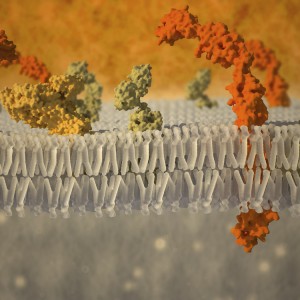 Lung cancer can develop as a consequence of a protein named Ras, either through its mutation or because it is present in the wrong place at a certain point in time.
Lung cancer can develop as a consequence of a protein named Ras, either through its mutation or because it is present in the wrong place at a certain point in time.
In the quest to find an efficient drug for lung cancer, researchers have tried to target Ras using different types of approaches. Now, a team led by Professor Dimitrios Stamou, University of Copenhagen, has discovered a novel way for Ras to become correctly placed within a cell, which may hold important implications in new approaches for cancer treatment.
The study, titled “Membrane curvature enables N-Ras lipid anchor sorting to liquid-ordered membrane phases”, was published in the prestigious journal Nature Chemical Biology.
Ras proteins reside within the inner wall of every cell in the human body, and have the capacity to activate cellular division and growth. As such, uncontrolled activation of Ras proteins (misregulation) can transform healthy cells into malignant ones, and lead to cancer development. In fact, it only takes an incorrect placement on the cell wall to initiate Ras misregulation.
In their new study, the team found that Ras cannot reach its correct location if the cell membrane has the wrong shape. “If the curvature of the cell is right, Ras goes to the right place. If the membrane is too straight or too bent, it does not. And Ras is very much like any other worker. If it never finds the way to its work place, it is not likely to get any work done”, explained Professor Stamou in a news release.
Over the last 30 years researchers have not been successful in targeting the Ras protein, and consequently, it has gained the reputation of the “undruggable cancer target”. However, Professor Stamou and his team have a new hypothesis, “If Ras goes off the rails because of changes in the curvature of the cell, perhaps we should target whatever changes the shape of the cell membrane. This is a change of perspective similar to when we went from flying with hot air balloons to taking off with fixed wings and propellers”.
Using artificial cell membranes of different sizes, the team found that Ras preferentially attaches itself to smaller vesicles. “For more than a decade people thought that the constituents of the cell wall was the thing that controlled where Ras was localized. We have shown, that at least one other aspect, namely membrane curvature, governs where Ras ends up in the cell and is therefore likely to be a factor in cancer development,” Jannik Bruun Larsen, a Post Doc in Professor Stamou’s lab, said in the news release.
The next big step is to take this research into in vivo models. “It will be ten times more difficult to uncover these effects in living systems but it needs to happen. We have started and we really hope others will follow”, explained Professor Dimitrios Stamou. “It may prove complicated to develop a drug that changes the shape of cells but I am certain that the discovery of the shape/misregulation-correlation will at least lead to new ways to diagnose cancers”, he added.


